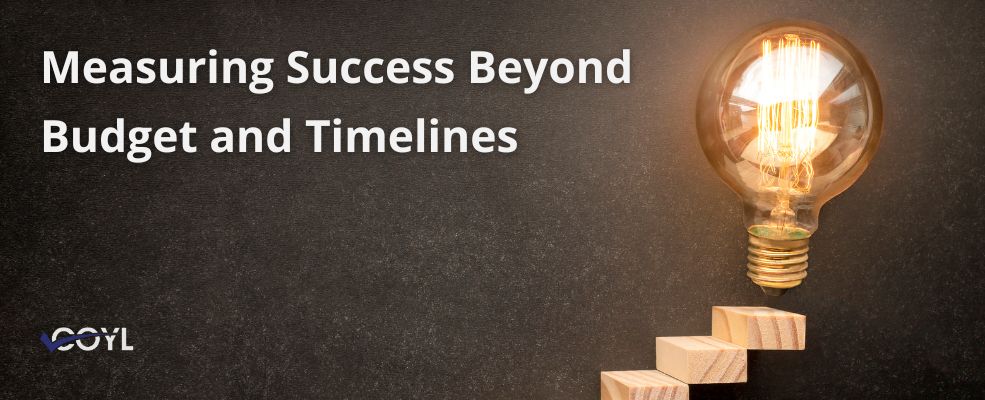Expanding the definition of project success requires a broader perspective that goes beyond mere financial metrics and strict timelines. True success encompasses various elements, including stakeholder satisfaction, team well-being, and the project’s overall impact on the organization and its culture. In this blog, we will explore these vital aspects and how they contribute to a more holistic understanding of what it means to achieve success in project management.
Traditional Success Metrics
Regarding project management, the traditional success metrics have always focused on two key factors:
- Budget Adherence: Assessing whether a project stays within the financial constraints established at its inception through accurate estimation, regular meetings, and stakeholder communication.
- Timeline Compliance: Evaluating whether all project tasks and deliverables are completed by the established deadlines, which are managed through clear scheduling, progress tracking, and adaptability.
While these are undoubtedly important, measuring success solely by these criteria often overlooks other critical elements that can significantly impact a project’s long-term benefits.
Alternative Success Metrics
As project management evolves, it’s important to explore new ways to measure success that provide a fuller picture of a project’s results. By examining these metrics, project managers can better understand the real impact of their projects and ensure all aspects of success are recognized and understood. This section will discuss these alternative metrics and their significance and offer tips on using them effectively in project evaluations.
1. Stakeholder Satisfaction
One of the most important aspects of any project is stakeholder satisfaction. This includes everyone involved in or affected by the project, from team members to clients and end-users. Engaging stakeholders throughout the project lifecycle is crucial for success. Project managers can spot potential issues early by involving them from the start, allowing for timely interventions. This proactive approach fosters a sense of ownership among stakeholders and keeps everyone aligned toward common goals. When stakeholders feel valued and heard, it boosts collaboration and drives the project forward effectively.

Consider the following approaches when evaluating stakeholder satisfaction:
Surveys and Feedback
- How To: Design and distribute regular surveys to stakeholders at different stages of the project. Use clear, concise questions to gauge their experiences, expectations, and satisfaction.
- Tools: Create and analyze surveys using online survey platforms like SurveyMonkey, Google Forms, or Typeform. These tools offer templates and analytics features that can help you understand stakeholder sentiments.
Engagement Levels
- How To: Implement engagement metrics throughout the project by regularly checking in with stakeholders. Use tools such as polls or quick feedback forms during meetings to assess their feelings of involvement and satisfaction.
- Tools: Consider using collaboration platforms like Slack or Microsoft Teams to facilitate quick engagement checks. Also, project management tools like Trello or Asana can help track stakeholder interactions and contributions.
Post-Project Reviews
- How To: Organize review sessions once the project is completed. Invite stakeholders to discuss the outcomes, successes, and areas for improvement. Encourage open dialogue to gain deeper insights into their needs and expectations.
- Tools: Video conferencing tools like Zoom or Microsoft Teams facilitate remote discussions. For documentation and analysis, tools like Miro or Google Docs can be used to capture insights and create a summary report.
Case Study: The Heathrow Terminal 5 Project
Overview: Heathrow Airport’s Terminal 5 (T5) is frequently recognized as a successful endeavor, especially for its approach to stakeholder engagement. Completed in 2008, this large-scale infrastructure project included a variety of stakeholders, such as the British Airport Authority (BAA), airlines, government agencies, local communities, and environmental organizations.
Challenges:
Complex Stakeholder Environment: The project encountered difficulties because of the numerous stakeholders with diverse interests. Project managers needed to balance the requirements of airlines, passengers, government regulations, and local communities.
Environmental Concerns: Major concerns regarding the new terminal’s environmental impact needed to be resolved to prevent delays and opposition from the public.
Stakeholder Engagement Strategy:
Early and Continuous Involvement: BAA initiated stakeholder engagement at the outset of the planning phase. Ongoing discussions with local communities, environmental organizations, and government agencies facilitated the identification of potential concerns and fostered trust.
Transparent Communication: BAA ensured clear communication with stakeholders, keeping them updated on progress and any challenges encountered.
Collaborative Problem Solving: The project team collaborated with stakeholders to tackle concerns, especially regarding environmental matters. For instance, BAA developed a thorough environmental management plan featuring strategies to reduce noise pollution and enhance air quality.
Outcomes:
On-time Delivery: Despite its complexity, T5 was finished on schedule and within budget—an uncommon accomplishment for a project of this scale.
Operational Success: The terminal launched successfully, encountering only a few operational issues.
Positive Stakeholder Relationships: The proactive engagement strategy fostered strong stakeholder relationships, reducing resistance and boosting the project’s reputation.
Key Takeaways:
Engaging stakeholders early and consistently can reduce risks and foster trust.
Open communication and teamwork are essential for tackling stakeholder issues and achieving project success.
A thoughtfully implemented stakeholder engagement strategy can result in successful projects and foster enduring positive relationships.
This case study emphasizes the vital role of stakeholder engagement in successfully delivering complex projects. By involving all relevant parties, project managers gain diverse insights, identify risks early, and foster ownership among stakeholders, leading to better decision-making and smoother execution.
2. Long-Term Impact
Another alternative metric for measuring success is a project’s long-term impact. After a project reaches initial completion, the focus often shifts to immediate outcomes. However, assessing and understanding the lasting benefits that develop over time is crucial. Did the project meet its long-term goals?
This evaluation is vital not only for understanding its success but also for guiding future initiatives. By looking beyond initial results, organizations can gain insights into the sustainability and relevance of their efforts. This metric evaluates how the project contributes to the organization’s goals over time.
Consider the following factors:
Assess the Sustainability of Benefits
- How To: After the project is completed, conduct follow-up evaluations at set intervals (e.g., 6 months, 1 year) to measure the ongoing impact of the project’s benefits.
- Tools: To gather data on sustained benefits, use surveys, feedback forms, and performance metrics tracking tools like Google Analytics or custom dashboards.
Evaluate Alignment with Strategic Goals
- How To: Review the organization’s strategic objectives and map the project’s outcomes against these goals. Conduct stakeholder interviews to gauge perceived alignment.
- Tools: Project management software (e.g., Trello, Asana) helps visualize project alignment, outcomes, and SWOT analysis frameworks to assess strategic fit.
Document Lessons Learned
- How To: Create a dedicated document or space to capture insights and lessons throughout the project lifecycle. After the project is completed, hold a retrospective meeting with the team to discuss experiences and outcomes.
- Tools: Use collaborative tools like Confluence or Google Docs for real-time documentation and project management software to integrate lessons learned into future project planning.
Often, when projects are evaluated over an extended period, they reveal benefits that far surpass their initial goals. For example, implementing a new Customer Relationship Management (CRM) system might streamline operations and enhance customer satisfaction and retention over the years.
By broadening the scope of success metrics to include stakeholder satisfaction and long-term impact, organizations can develop a more nuanced understanding of project success and drive even greater results in the future.
Industry-Specific Implementation Ideas for Measuring Success Beyond Budget and Timelines
To really understand measuring success beyond just budgets and timelines, let’s look at specific examples for measuring success in different industries. This exploration will give us useful insights into how success can be defined and assessed in different contexts, helping us better understand performance in various fields.
Measuring Success for Real Estate Professionals
In the real estate sector, success is often defined by sales figures and adherence to timelines, but there are additional dimensions that can significantly impact an agent’s effectiveness and reputation.
Client Satisfaction and Referrals
Metric: One of the most telling indicators of success is client satisfaction. Tracking this through post-sale surveys can provide invaluable insights into the client experience. Additionally, the number of referrals generated from past clients is a crucial metric.
Implementation: Establish a follow-up system to check in with clients after a transaction. This shows you care and provides a platform to gather feedback to enhance your services. Creating a referral program can further incentivize satisfied clients to refer their friends and family.
Property Turnaround Time
Metric: Understanding how quickly properties sell or lease is essential. Measuring the average time from listing to closing gives agents a clear indicator of their efficiency in the market.
Implementation: Analyze market data to set realistic expectations for clients and optimize your marketing strategies. This can help reduce property turnaround times, benefiting both the client and your overall performance.
Community Impact and Engagement
Metric: A real estate agent’s reputation within the community can greatly influence their success. Metrics such as involvement in local events, sponsorships, and contributions to local causes can provide a deeper understanding of an agent’s community footprint.
Implementation: Actively engage in community activities, sponsor local events, and participate in charities. These efforts help build a positive brand image and foster meaningful relationships within the community, which can lead to more business opportunities.
Market Adaptability
Metric: The ability to adapt to market changes is critical in the fast-paced world of real estate. Measuring how quickly and effectively you can respond to shifts in property demand, pricing trends, or regulatory changes is essential for long-term success.
Implementation: Stay informed about market trends and be ready to adjust your business strategies. This includes revising pricing structures, enhancing marketing efforts, and updating service offerings to meet evolving client needs.
Measuring Success for Business Coaches
In business coaching, providing the best service to your clients requires a complete approach that goes beyond traditional measures. This means using a strategy that looks at the different challenges and goals of each person or organization. By doing this, you can give them personalized advice and support to help them grow and succeed in a sustainable way.
Client Progress and Achievement
Metric: One of the primary indicators of success in coaching is the progress clients make towards their goals and the milestones they achieve during sessions.
Implementation: To effectively monitor this, develop a structured tracking system that allows for regular reviews. This system should enable coaches to adjust their strategies based on the progress observed, ensuring that clients remain on track to meet their objectives.
Client Retention and Satisfaction
Metric: Client retention rates, satisfaction scores, and the number of referrals generated from existing clients.
Implementation: Regular check-ins and satisfaction surveys can provide valuable insights into client experiences. Based on the feedback, adapt coaching methods to improve retention and overall satisfaction. This proactive approach fosters stronger relationships and loyalty among clients.
Impact on Business Performance
Metric: Tangible improvements in clients’ businesses, such as revenue growth, enhanced efficiency, or successful strategy implementation.
Implementation: Conduct before-and-after analyses to showcase the direct impact of coaching on business performance. These insights not only highlight the effectiveness of coaching but also serve as a foundation for refining future coaching approaches.
Personal and Professional Development
Metric: The personal growth of clients is a significant indicator of success, encompassing improvements in leadership, decision-making, and work-life balance.
Implementation: Incorporate personal development goals into coaching sessions and utilize self-assessment tools to monitor progress over time. By prioritizing personal growth, coaches can enhance their clients’ overall effectiveness and fulfillment in both their professional and personal lives.
Adapting to Change and Flexibility
Mastering the ability to adapt to change is more crucial than ever in todays fast paced operational environment. Organizations must embrace flexibility not only to survive but to thrive. One effective approach to achieving this is through agile project management, which fosters a culture of responsiveness and innovation.
Importance of Agile Project Management
Agile project management is a methodology that prioritizes flexibility and adaptability over rigid planning. It allows teams to respond quickly to changes in project scope, market demands, and customer feedback. By breaking projects into smaller, manageable increments, teams can assess progress and make adjustments in real time. This iterative approach not only enhances collaboration among team members but also encourages a mindset of continuous improvement, ultimately leading to better project outcomes.

How Adaptability Leads to Success
Adaptability is a key driver of success in any project. When teams are open to change, they often uncover new opportunities that may have been overlooked in a more traditional project management framework. For instance, an unexpected shift in customer preferences or market trends can prompt a team to pivot their strategy, leading to innovative solutions and enhanced results. Embracing adaptability not only helps teams navigate challenges but also positions them to capitalize on unforeseen opportunities, fostering a competitive advantage.
Real-Life Scenarios of Adaptability
To illustrate the power of adaptability, consider the following example that highlight how flexibility can lead to success.
Spotify’s Agile Approach to Product Development
- Scenario: Spotify, the well-known music streaming platform, encountered the challenge of quickly scaling its services while consistently launching new features for millions of users. Initially, the company adopted a conventional project management method but soon realized it was too inflexible and sluggish to meet market demands effectively.
- Flexibility: Spotify embraced an Agile approach by implementing a “squad” model, which involves small, cross-functional teams (squads) empowered to independently tackle various aspects of the product. This level of autonomy enabled teams to swiftly pivot, experiment, and adjust to evolving user demands and market dynamics.
- Outcome: This strategy allowed Spotify to accelerate innovation, consistently enhance its product, and retain a competitive advantage in the streaming sector. Additionally, the adaptable framework encouraged a culture of experimentation and learning, which played a vital role in the company’s swift growth.
Conclusion
By broadening our perspective on project success, we can uncover deeper, meaningful insights into what makes a project successful. This holistic approach can lead to more sustainable, impactful outcomes for small business owners, loan officers, realtors, business coaches, and entrepreneurs.
Incorporate these broader metrics into your project management practices, and you’ll not only meet your deadlines and stay within budget—you’ll achieve success that resonates well beyond the project’s completion.
Need help incorporating broader metrics into your project management practices? Let’s work together to make it happen! Click here.





